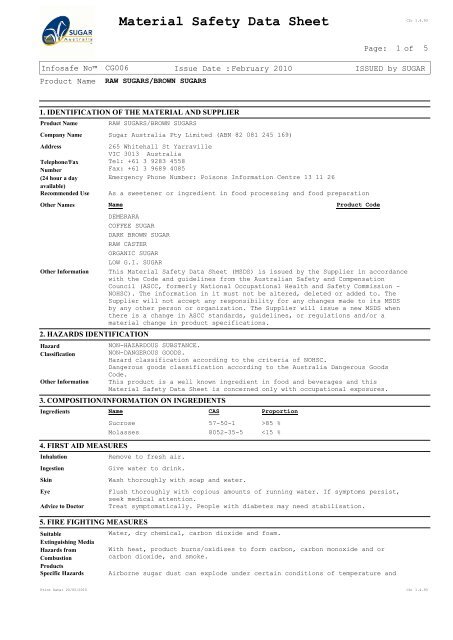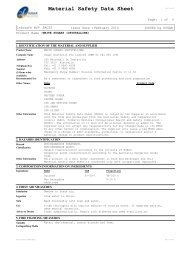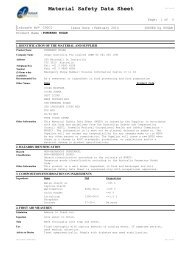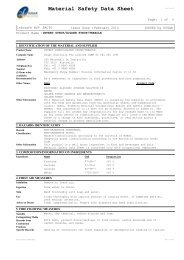Raw and Brown Sugars - Sugar Australia
Raw and Brown Sugars - Sugar Australia
Raw and Brown Sugars - Sugar Australia
You also want an ePaper? Increase the reach of your titles
YUMPU automatically turns print PDFs into web optimized ePapers that Google loves.
Material Safety Data Sheet<br />
Page: 1<br />
CS: 1.4.93<br />
Infosafe No CG006 Issue Date : February 2010 ISSUED by SUGAR<br />
Product Name : RAW SUGARS/BROWN SUGARS<br />
1. IDENTIFICATION OF THE MATERIAL AND SUPPLIER<br />
Product Name RAW SUGARS/BROWN SUGARS<br />
Company Name <strong>Sugar</strong> <strong>Australia</strong> Pty Limited (ABN 82 081 245 169)<br />
Address 265 Whitehall St Yarraville<br />
VIC 3013 <strong>Australia</strong><br />
Telephone/Fax Tel: +61 3 9283 4558<br />
Number<br />
Fax: +61 3 9689 4085<br />
(24 hour a day<br />
available)<br />
Emergency Phone Number: Poisons Information Centre 13 11 26<br />
Recommended Use As a sweetener or ingredient in food processing <strong>and</strong> food preparation<br />
Other Names<br />
Name<br />
DEMERARA<br />
COFFEE SUGAR<br />
DARK BROWN SUGAR<br />
RAW CASTER<br />
ORGANIC SUGAR<br />
LOW G.I. SUGAR<br />
Product Code<br />
Other Information This Material Safety Data Sheet (MSDS) is issued by the Supplier in accordance<br />
with the Code <strong>and</strong> guidelines from the <strong>Australia</strong>n Safety <strong>and</strong> Compensation<br />
Council (ASCC, formerly National Occupational Health <strong>and</strong> Safety Commission -<br />
NOHSC). The information in it must not be altered, deleted or added to. The<br />
Supplier will not accept any responsibility for any changes made to its MSDS<br />
by any other person or organization. The Supplier will issue a new MSDS when<br />
there is a change in ASCC st<strong>and</strong>ards, guidelines, or regulations <strong>and</strong>/or a<br />
material change in product specifications.<br />
2. HAZARDS IDENTIFICATION<br />
Hazard<br />
Classification<br />
NON-HAZARDOUS SUBSTANCE.<br />
NON-DANGEROUS GOODS.<br />
Hazard classification according to the criteria of NOHSC.<br />
Dangerous goods classification according to the <strong>Australia</strong> Dangerous Goods<br />
Code.<br />
Other Information This product is a well known ingredient in food <strong>and</strong> beverages <strong>and</strong> this<br />
Material Safety Data Sheet is concerned only with occupational exposures.<br />
3. COMPOSITION/INFORMATION ON INGREDIENTS<br />
Ingredients<br />
Name<br />
4. FIRST AID MEASURES<br />
CAS Proportion<br />
Sucrose 57-50-1 >85 %<br />
Molasses 8052-35-5
Material Safety Data Sheet<br />
Page: 2<br />
CS: 1.4.93<br />
Infosafe No CG006 Issue Date : February 2010 ISSUED by SUGAR<br />
Product Name : RAW SUGARS/BROWN SUGARS<br />
Precautions in<br />
connection with Fire<br />
humidity <strong>and</strong> in the presence of an ignition source when the concentration<br />
exceeds 25 grams per cubic metre. Intrinsically safe dust extraction systems,<br />
cleaning procedures, electrical earthing <strong>and</strong> other safety measures must be<br />
used to avoid the risk of explosion. Incompatible with strong oxidising<br />
agents.<br />
Fire-fighters should wear full protective clothing <strong>and</strong> self contained<br />
breathing apparatus (SCBA) operated in positive pressure mode.<br />
6. ACCIDENTAL RELEASE MEASURES<br />
Emergency<br />
Procedures<br />
7. HANDLING AND STORAGE<br />
Precautions for Safe<br />
H<strong>and</strong>ling<br />
Conditions for Safe<br />
Storage<br />
Remove sources of ignition. Increase ventilation. Sweep up material avoiding<br />
dust generation, vacuum, or dampen spilled material with water to avoid<br />
airborne dust, then transfer material to a suitable container. Wash area with<br />
water ensuring all wash water is captured <strong>and</strong> discharged to an approved<br />
treatment facility. Notify relevant waste or environmental authority as<br />
required by the site's EPA licence, trade waste agreement <strong>and</strong>/or State<br />
legislation.<br />
Material can ferment if excessive moisture contamination is allowed.<br />
Fermentation can yield carbon dioxide with possible traces of ethanol or<br />
volatile fatty acids (e.g. acetic, propionic, lactic, or butyric) <strong>and</strong> if<br />
exposed to a spark or flame may result in an explosion. These conditions<br />
should be avoided. Airborne sugar dust can explode under certain conditions.<br />
Refer to Section 5: Fire Fighting Measures: Specific hazards. If maintenance<br />
of a storage bin / vessel requires entry by personnel, confined space<br />
precautions should be complied with. Insufficient oxygen may be present in<br />
vessels containing the product due to the generation of gases during<br />
fermentation.<br />
Use only in a well ventilated area. Keep containers sealed when not in use.<br />
Prevent the build up of dust in the work atmosphere. Avoid inhalation of dust,<br />
<strong>and</strong> skin or eye contact. Establish good housekeeping practices. Remove dust<br />
accumulations on a regular basis by vacuuming or gentle sweeping to avoid<br />
creating dust clouds. Maintain high st<strong>and</strong>ards of personal hygiene ie. Washing<br />
h<strong>and</strong>s prior to eating, drinking, smoking or using toilet facilities.<br />
This product should be stored in its factory packaging in a cool, dry, well<br />
ventilated area, away from sources of ignition, oxidising agents <strong>and</strong> out of<br />
moisture. Keep containers closed when not in use.<br />
Other Information For further information refer to <strong>Sugar</strong> <strong>Australia</strong>'s 'Granulated White <strong>Sugar</strong><br />
Storage <strong>and</strong> H<strong>and</strong>ling in Bulk', <strong>Sugar</strong> <strong>Australia</strong>'s 'Explosion Risk Management<br />
<strong>and</strong> Housekeeping St<strong>and</strong>ards for <strong>Sugar</strong>'.<br />
8. EXPOSURE CONTROLS/PERSONAL PROTECTION<br />
National Exposure<br />
St<strong>and</strong>ards<br />
Biological Limit<br />
Values<br />
Engineering<br />
Controls<br />
Respiratory<br />
Protection<br />
No exposure st<strong>and</strong>ards have been established for this material, however, the<br />
TWA National Occupational Health And Safety Commission (NOHSC) exposure<br />
st<strong>and</strong>ards for dust not otherwise specified is 10 mg/m³. TWA (Time Weighted<br />
Average): The average airborne concentration of a particular substance when<br />
calculated over a normal eight-hour working day, for a five-day week.<br />
No Biological limit available.<br />
General room ventilation should be adequate, but local mechanical ventilation<br />
may be required if dust is generated, particularly in confined spaces. Work<br />
areas should be cleaned regularly by gentle or wet sweeping or vacuuming.<br />
An approved particulate respirator conforming to <strong>Australia</strong>n St<strong>and</strong>ards AS/NZS<br />
1715 <strong>and</strong> AS/NZS 1716 should be worn when working with dusts. Respirators<br />
should be correctly fitted, maintained in good condition, <strong>and</strong> kept in clean<br />
storage when not in use. Replaceable filters <strong>and</strong> cartridges should be replaced<br />
regularly in accordance with the manufacturers' guidelines <strong>and</strong> <strong>Australia</strong>n<br />
St<strong>and</strong>ards AS/NZS 1715 <strong>and</strong> AS/NZS 1716. Use only respirators that bear the<br />
<strong>Australia</strong>n St<strong>and</strong>ards mark <strong>and</strong> are fitted <strong>and</strong> maintained correctly, <strong>and</strong> kept in<br />
clean storage when not in use.<br />
Eye Protection Ventilated non-fogging goggles, splash resistant should be worn if dust is<br />
generated. Final choice of appropriate eye/face protection will vary according<br />
to individual circumstances. Eye protection devices should conform with<br />
<strong>Australia</strong>n/New Zeal<strong>and</strong> St<strong>and</strong>ard AS/NZS 1337 - Eye Protectors for Industrial<br />
Print Date: 20/05/2010 CS: 1.4.93<br />
of<br />
5
Material Safety Data Sheet<br />
Page: 3<br />
CS: 1.4.93<br />
Infosafe No CG006 Issue Date : February 2010 ISSUED by SUGAR<br />
Product Name : RAW SUGARS/BROWN SUGARS<br />
Applications.<br />
H<strong>and</strong> Protection Wear gloves of impervious material(such as PVC coated fabric). Final choice of<br />
appropriate gloves will vary according to individual circumstances i.e.<br />
methods of h<strong>and</strong>ling or according to risk assessments undertaken. Reference<br />
should be made to AS/NZS 2161.1: Occupational protective gloves - Selection,<br />
use <strong>and</strong> maintenance.<br />
Personal Protective If engineering controls <strong>and</strong> work practices are not effective in controlling<br />
Equipment<br />
exposure, then personal protective equipment may be required.<br />
Body Protection Skin Protection: Direct skin contact should be avoided by wearing long sleeved<br />
shirts <strong>and</strong> long trousers, a cap or hat, <strong>and</strong> gloves (PVC coated fabric or<br />
equivalent AS 2161). Work clothes should be washed regularly.<br />
9. PHYSICAL AND CHEMICAL PROPERTIES<br />
Appearance Light to dark brown crystals<br />
Odour Sweet odour<br />
Melting Point 160-186°C<br />
Boiling Point Decomposes with heat.<br />
Solubility in Water 2 kg per litre<br />
Specific Gravity 1.59<br />
pH Value Not available<br />
Vapour Pressure Not applicable<br />
Vapour Density<br />
(Air=1)<br />
Not applicable<br />
Evaporation Rate Not applicable<br />
Flash Point Not applicable<br />
Flammability Combustible, product will burn in surrounding fire situation.<br />
Auto-Ignition<br />
500°C<br />
Temperature<br />
Flammable Limits - Combustible<br />
Lower<br />
Flammable Limits - Combustible<br />
Upper<br />
Explosion Limit - 25-45 g/m³<br />
Lower<br />
Solubility in other Not applicable<br />
solvents (kg/m3)<br />
Other Information For further information refer to <strong>Sugar</strong> <strong>Australia</strong>'s 'White <strong>Sugar</strong> Properties'.<br />
10. STABILITY AND REACTIVITY<br />
Chemical Stability Stable<br />
Conditions to Avoid Heat, flames <strong>and</strong> other ignition sources.<br />
Incompatible<br />
Materials<br />
Hazardous<br />
Decomposition<br />
Products<br />
Hazardous<br />
Polymerization<br />
Incompatible with oxidising agents.<br />
Carbon dioxide <strong>and</strong> carbon monoxide may form when heated to decomposition.<br />
Ethanol or volatile fatty acids (e.g. acetic, propionic, lactic or butyric) if<br />
fermentation occurs.<br />
Will not occur.<br />
11. TOXICOLOGICAL INFORMATION<br />
Toxicology<br />
Toxicity Data: Non-toxic – a foodstuff<br />
Information<br />
Sucrose: LD50 (Ingestion) : 29,700 mg/kg (rat)<br />
Inhalation <strong>Sugar</strong> dust may irritate the nose <strong>and</strong> throat.<br />
Print Date: 20/05/2010 CS: 1.4.93<br />
of<br />
5
Material Safety Data Sheet<br />
Page: 4<br />
CS: 1.4.93<br />
Infosafe No CG006 Issue Date : February 2010 ISSUED by SUGAR<br />
Product Name : RAW SUGARS/BROWN SUGARS<br />
Ingestion No health effects under normal conditions of industrial use, but ingestion may<br />
destabilise people with diabetes.<br />
Skin Skin contact may result in mild skin irritation.<br />
Eye Irritating to the eyes <strong>and</strong> may cause watering <strong>and</strong> redness.<br />
Chronic Effects Repeated exposure to the powder <strong>and</strong> dust may result in increased nasal <strong>and</strong><br />
respiratory secretions <strong>and</strong> coughing, but not irreversible health effects.<br />
Repeated skin contact may cause dermatitis.<br />
12. ECOLOGICAL INFORMATION<br />
Ecotoxicity Non-toxic to aquatic <strong>and</strong> terrestrial organisms. Sucrose is an oxygen depleting<br />
substance in aquatic environments.<br />
Persistence /<br />
Not available<br />
Degradability<br />
Mobility Not available<br />
Environ. Protection Do not discharge product unmonitored into the environment.<br />
13. DISPOSAL CONSIDERATIONS<br />
Disposal<br />
Considerations<br />
14. TRANSPORT INFORMATION<br />
Transport<br />
Information<br />
IMDG Marine<br />
Pollutant (MP)<br />
15. REGULATORY INFORMATION<br />
Poisons Schedule Not Scheduled<br />
Product can be treated as a common waste for disposal to an organic recycler<br />
or into a l<strong>and</strong>fill site / wastewater treatment plant in accordance with<br />
relevant Authority guidelines. Note Biochemical Oxygen Dem<strong>and</strong> load in waste<br />
water streams. Return product to supplier for re-use / recycling if possible.<br />
Consult supplier for recycling options. Recycle containers if possible or<br />
dispose of in an authorised l<strong>and</strong>fill. Transportation of wet sugar waste may<br />
require Waste Transport Certification. Refer to your local Environment<br />
Protection Authority.<br />
Not classified as a Dangerous Good, according to the <strong>Australia</strong>n Code for the<br />
Transport of Dangerous Goods by Road <strong>and</strong> Rail<br />
Not a marine pollutant.<br />
AICS (<strong>Australia</strong>) All components of this product are listed on the <strong>Australia</strong>n Inventory of<br />
Chemical Substances (AICS), or otherwise are in compliance with the NICNAS<br />
requirements.<br />
16. OTHER INFORMATION<br />
Date of preparation MSDS created: February 2010<br />
or last revision of<br />
MSDS<br />
Contact Person/Point Emergency Contact Number: Poisons Information Centre 13 11 26<br />
For further information on this product, please contact the following:<br />
<strong>Sugar</strong> <strong>Australia</strong> Pty Limited<br />
ABN 82 081 245 169<br />
265 Whitehall St Yarraville VIC 3013 <strong>Australia</strong><br />
Telephone: 61 3 9283 4558<br />
Facsimile: 61 3 9689 4085<br />
Literature<br />
<strong>Australia</strong>n St<strong>and</strong>ards References:<br />
References<br />
AS/NZS 1336 Recommended Practices for Occupational Eye Protection.<br />
AS/NZS 1715 Selection, Use <strong>and</strong> Maintenance of Respiratory Protective Devices.<br />
AS/NZS 1716 Respiratory Protective Devices.<br />
AS 2161 Industrial Safety Gloves <strong>and</strong> Mittens (excluding electrical <strong>and</strong> medical<br />
gloves).<br />
National Code of Practice for the Preparation of Material Safety Data Sheets<br />
2nd Edition [NOHSC:2011(2003)], April<br />
2003, National Occupational Health <strong>and</strong> Safety Commission.<br />
<strong>Sugar</strong> <strong>Australia</strong>'s 'Granulated White <strong>Sugar</strong> Storage <strong>and</strong> H<strong>and</strong>ling in Bulk'<br />
<strong>Sugar</strong> <strong>Australia</strong>'s 'Explosion Risk Management <strong>and</strong> Housekeeping St<strong>and</strong>ards for<br />
<strong>Sugar</strong>'<br />
<strong>Sugar</strong> <strong>Australia</strong>'s 'White <strong>Sugar</strong> Properties'<br />
Print Date: 20/05/2010 CS: 1.4.93<br />
of<br />
5
Material Safety Data Sheet<br />
Page: 5<br />
CS: 1.4.93<br />
Infosafe No CG006 Issue Date : February 2010 ISSUED by SUGAR<br />
Product Name : RAW SUGARS/BROWN SUGARS<br />
<strong>Sugar</strong> <strong>Australia</strong>'s 'White <strong>Sugar</strong> Properties'<br />
Other Information Whilst the information contained in this document is based on data which, to<br />
the best of our knowledge, was accurate <strong>and</strong> reliable at the time of<br />
preparation, no responsibility can be accepted by us for errors <strong>and</strong> omissions.<br />
The provision of this information should not be construed as a recommendation<br />
to use any of our products in violation of any patent rights or in breach of<br />
any statute or regulation. Users are advised to make their own determination<br />
as to the suitability of this information in relation to their particular<br />
purposes <strong>and</strong> specific circumstances. Since the information contained in this<br />
document may be applied under conditions beyond our control, no responsibility<br />
can be accepted by us for any loss or damage caused by any person acting or<br />
refraining from action as a result of this information.<br />
...End Of MSDS...<br />
© Copyright ACOHS Pty Ltd<br />
Copyright in the source code of the HTML, PDF, XML, XFO <strong>and</strong> any other electronic files rendered by an Infosafe system for Infosafe MSDS displayed is the intellectual<br />
property of Acohs Pty Ltd.<br />
Copyright in the layout, presentation <strong>and</strong> appearance of each Infosafe MSDS displayed is the intellectual property of Acohs Pty Ltd.<br />
The compilation of MSDS's displayed is the intellectual property of Acohs Pty Ltd.<br />
Copying of any MSDS displayed is permitted for personal use only <strong>and</strong> otherwise is not permitted. In particular the MSDS's displayed cannot be copied for the purpose of<br />
sale or licence or for inclusion as part of a collection of MSDS without the express written consent of Acohs Pty Ltd.<br />
Print Date: 20/05/2010 CS: 1.4.93<br />
of<br />
5





